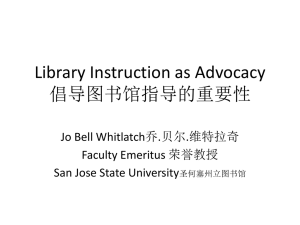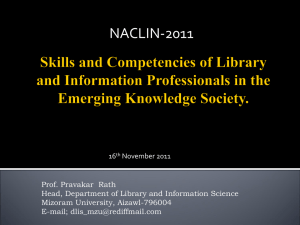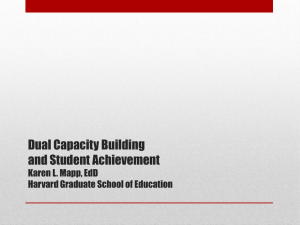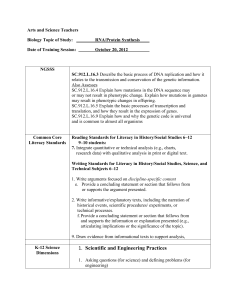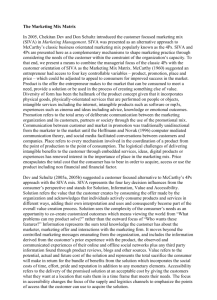Library Instruction as Advocacy - Evergreen Education Organization
advertisement
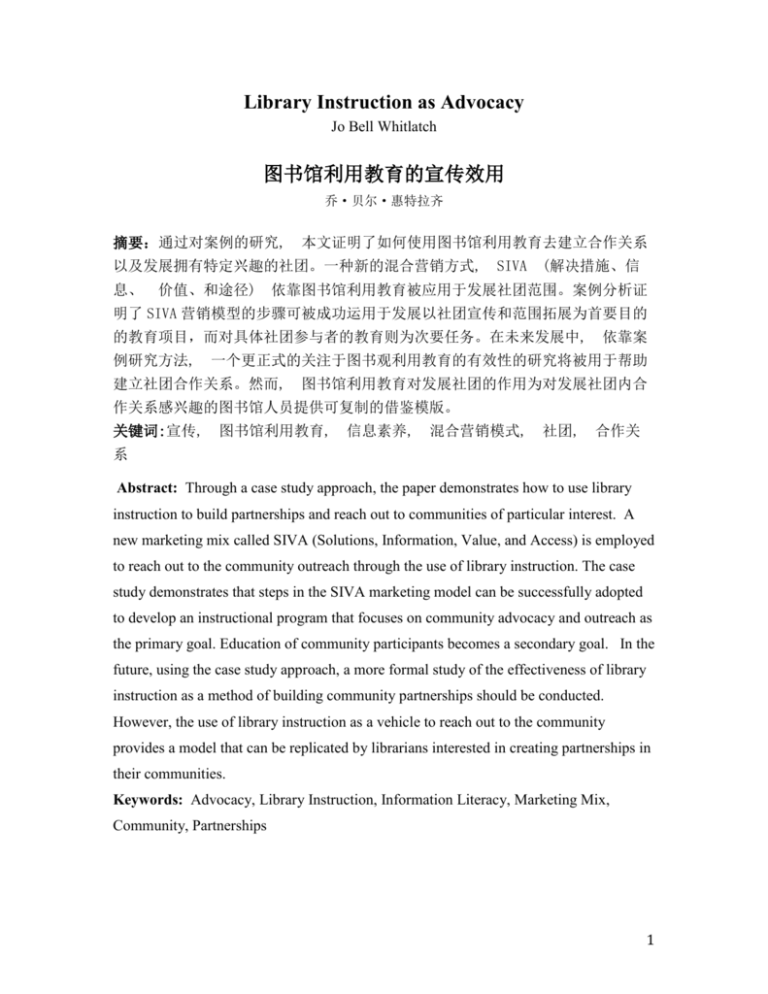
Library Instruction as Advocacy Jo Bell Whitlatch 图书馆利用教育的宣传效用 乔·贝尔·惠特拉齐 摘要:通过对案例的研究, 本文证明了如何使用图书馆利用教育去建立合作关系 以及发展拥有特定兴趣的社团。一种新的混合营销方式, 息、 价值、和途径) SIVA (解决措施、信 依靠图书馆利用教育被应用于发展社团范围。案例分析证 明了 SIVA 营销模型的步骤可被成功运用于发展以社团宣传和范围拓展为首要目的 的教育项目,而对具体社团参与者的教育则为次要任务。在未来发展中, 例研究方法, 依靠案 一个更正式的关注于图书观利用教育的有效性的研究将被用于帮助 建立社团合作关系。然而, 图书馆利用教育对发展社团的作用为对发展社团内合 作关系感兴趣的图书馆人员提供可复制的借鉴模版。 关键词:宣传, 图书馆利用教育, 信息素养, 混合营销模式, 社团, 合作关 系 Abstract: Through a case study approach, the paper demonstrates how to use library instruction to build partnerships and reach out to communities of particular interest. A new marketing mix called SIVA (Solutions, Information, Value, and Access) is employed to reach out to the community outreach through the use of library instruction. The case study demonstrates that steps in the SIVA marketing model can be successfully adopted to develop an instructional program that focuses on community advocacy and outreach as the primary goal. Education of community participants becomes a secondary goal. In the future, using the case study approach, a more formal study of the effectiveness of library instruction as a method of building community partnerships should be conducted. However, the use of library instruction as a vehicle to reach out to the community provides a model that can be replicated by librarians interested in creating partnerships in their communities. Keywords: Advocacy, Library Instruction, Information Literacy, Marketing Mix, Community, Partnerships 1 Introduction Information Literacy classes taught by librarians have typically been focused on the content of what students or the public needs to know in order to be information literate, or to "recognize when information is needed and have the ability to locate, evaluate, and use effectively the needed information." (American Library Association, 1989) Certainly, information literacy skills are important for all citizens in our global society. So, why am I proposing that the primary goal of a library instruction class be not to teach information literacy in general or in a subject area, but rather to focus on community advocacy and outreach as the most important goal? Some very interesting research strongly suggests that typical information literacy classes may not be the most effective method of developing information literacy competencies in students or other target populations. Kiewra (2002) found that students record only 20-40 percent of a lecture’s main ideas in their notes. And, Bligh (2000, p. 40) notes that without reviewing the lecture material, students remember less than 10 percent after three weeks. These findings suggest that information literacy lectures might better serve to advocate the value of obtaining the competency, rather than actually trying to develop the skill. Defining Advocacy Advocacy concerns supporting or recommending ideas, policies, causes or programs. Advocacy involves changing attitudes, policies, positions, or practices in the community of interest. Advocacy involves planning for change, improving understanding, and planning for the future. For example, one of the causes that the American Library Association supports is Literacy: “Literacy is a fundamental value of the association and its members, and one of ALA's Key Action Areas. ALA and its divisions promote and foster literacy, and ensure that training and resources are available to help libraries and librarians develop literacy programs and services.” (Literacy/American Library Association, n.d.). The SIVA Marketing Mix In contrast to advocacy, the traditional marketing methods are about promoting and selling products or services to customers, including marketing research and advertising. The traditional marketing mix was an internally focused methodology known as the four P’s – price, product, place, and promotion. Traditional marketing methods, which were developed in a largely manufacturing economy and mostly focused on selling products rather than services, manipulated price, product, place and promotion to sell products that the firm had made (Dev & Schultz, 2005b). Dev and Schultz (2005a) propose a new marketing mix – SIVA- which is based upon the four key questions customers ask when 2 evaluating a product or service: Solutions, Information, Value, Access (SIVA), as illustrated in Table I. Table I: SIVA Marketing Mix Letter Marketing Mix Customer Question Element S Solutions How can I solve my problem? I Information Where can I learn more about it? V Value What is my total sacrifice to get this solution? A Access Where can I find it? This approach clearly puts the customer at the beginning of the process – developing products or services begins by focusing on the problems that customers are trying to solve. So the first step becomes understanding customers’ problems rather than developing products or services and trying to fit them to customer needs. Providing information to customers is less about promotion through advertising and more focused on assisting satisfied customers in providing feedback and information on products and services through various media, chat rooms, blogs, and other interactive media forums. Value, in contrast to Price, focuses on total customer costs of time and effort as well as money. Finally, today, the question is less about Place – what location sells the product or provides the service, and much more about Access, how can the fastest, easiest, least expensive access to the product or service be obtained? Therefore, the modern marketing mix is redefined as externally driven by the customer, rather than internally driven by managers of the firm. Dev and Schultz (2005b) outline the steps that constitute the customer-focused approach to marketing. These steps are outlined in Table II. Table II: Steps in the Customer Focused Marketing Approach Step 1: Understand Identify and clarify what customers value and determine whether markets and customer organization could use assets and resources to create products value and services that match customer values Step 2: Create Determine what customers want, need, and value, and then, customer value focus resources or assets on fulfilling customer wants, needs, and proposition values Step 3: Deliver Find ways to deliver the value that customers seek customer value Step 4: Measure the Measure the extent to which customer value was delivered value delivered 3 Reaching Out to Communities of Interest Through Partnerships The importance of partnerships in addressing community issues is highlighted in a recent International City/County Management Association (ICMA) report (2011). Six important lessons from these innovative projects were: 1. Library and local government leaders need to connect on community priorities. 2. Building partnerships is the key to innovation. 3. Leadership happens at all levels of an organization. 4. Successful partnerships require commitment to the effort. 5. Innovation occurs in communities of all sizes. 6. Not every effort will be successful. Traditional library services operate much like the traditional marketing programs. Library services, similar to the product of the business firm are already available – managers and their staff try to employ various factors in the environment to encourage customers to use the services or products. However, in the 21st century of marketing through use of models such as SIVA, with customer problems as the first step in the process, identifying the core information needs/problems of customers is essential. For example, for rural populations, Aboyade (1987) classifies information needs into the following categories – information for: - Increased productivity and income growth, such how to obtain seeds, credit, current prices - Rural non-farm economic activities, such as shoe-making, baking, arts and crafts - Social amenities, such as sources of safe drinking water, education - Social participation and political involvement, such as farmer cooperatives For all populations both urban and rural, libraries have the potential to impact people’s lives in the following broad domains: health, education, governance, employment & income, language & culture, and communications & leisure. Each community is unique in their needs or problems so reaching out involving knowing your community, the most urgent needs and the potential organizational partnerships within that community. Blake, Martin, and Du (2004, p. 52) outline the key characteristics of a community- centered library: 1. The library’s priority is on providing services to the individuals, organizations, businesses, and institutions in the community. 2. The library recognizes it exists because of the community and for the community. 3. The library staff knows people, not things, come first. 4. The library actively solicits input from various segments of the community. 4 5. The library facilitates partnerships between it and other agencies or between citizen groups and appropriate organizations. 6. Partnerships are beneficial to both the library and the partner. Traditionally libraries have focused most heavily on serving individual users who come to the library, virtually or in-person to use the resources that the libraries offer. However, effective community outreach that goes beyond working with individuals using library services, involving forming partnerships in one or more of the broad domains: health, education, governance, employment & income, language & culture, and communications & leisure. To form partnerships, the library must have a strategy – staff must ask and answer these questions: - What are the most important information needs/problems of people in our community? - Of the most important information needs/problems in the community, which of these does the library have at least some of the assets and resources to address? - For those important community information needs/problems for which the library has at least some assets and resources, are there potential community partners? After a list of the highest priority areas of community information needs/problems for the library to address have been identified, potential community partners need to be evaluated. Community businesses, and organizations in the following areas often have common overlapping interests with libraries in solving information needs/problems of local citizens in certain domains and often are very good partners: Chamber of Commerce or other organization representing business interests Workforce center Local government extension services office Family service organizations Senior Centers Health agencies Local educational institutions Local businesses, such as supermarkets and restaurants School age care and enrichment programs Museums Local history organizations Literary organizations, book clubs, Local musical and drama groups 5 Science and environmental organizations In determining potential partnerships, embedding librarians in local organizations allows the library to demonstrate value and discover in depth interests of community organizations (Galston, C, Huber, E.K., Johnson, K, and Long, A., 2012). The Wilder Collaboration Factors Inventory (Mattessich, P., Murray-Close, M., & Monsey, B., 2001) is very helpful in evaluating the suitability of community organizations as a collaborative partner for the library. A fee online inventory is available to assess the presence of organizational factors that are important in collaboration. Questions assist in evaluating factors such as mutual respect, understanding and trust; ability to compromise; members see collaboration as in their self-interest; members share a stake in both process and outcome; shared vision; sufficient funds, staff, materials, and time; and open and frequent communication. University Case Study Applying Steps in the SIVA Marketing Mix Communities of interest to libraries can be large, in the case of a public library serving an entire community, or smaller, for example, a special library in a firm or corporation, a school library in an elementary, middle, or high school, or an academic library in a college or university. The case study reports on collaborative relationships developed between the academic library and classroom faculty in a university setting. In this setting, partnership possibilities are both more limiting and somewhat easier to determine because of the more focused nature of the community. However, all of the same principles apply. This case study is based upon my library instruction experiences at San Jose State University (SJSU) in San Jose, California. SJSU (http://www.sjsu.edu/about_sjsu/) offers bachelor’s and master’s degrees in over 130 areas of study. Enrollment in each semester is about 30,000 students (or the equivalent of 20,000 students taking a full course load). The University Library has long employed a library liaison system whereby each librarian is responsible for developing cooperative relations with faculty in assigned departments in the areas of library instruction, collection management, and research. For many years I was assigned as History Liaison. Over the years, I found that formal library instruction presentations were most useful in terms of making students aware that the library offered a range of services that could assist them in completing their course assignments. Informal conversations with the students seeking help after the formal library instruction sessions had a significant impact upon my views concerning the role of library instruction. I found that students retained very little of the information presented in my instructional lectures, but came to me because of my advocacy of library services, which could save them time and result in higher quality assignments. Thus, I came to view library instruction as advocacy for use of library services. To assist students in acquiring and maintaining information literacy competencies, the most effective method is not library instruction but collaborative assignments that were developed between 6 librarian and classroom teacher and required students to actually apply information literacy skills in completing the assignments. However, an introductory instruction session focused on completing the class assignment definitely had a role, especially in advocating the use of library information sources, including high quality, authoritative Web sources. Table III: University Library Instructional Advocacy Applying the SIVA Marketing Mix Step 1 – Understand Markets and Customer For each academic department, meet with Value all full-time teachers with open ended interview questions focused on their needs, wants and values. Sample questions: 1. What are their research interests and teaching specialties? 2. How have they used libraries to meet their research needs? Their teaching needs? 3. What did they like about library services? 4. What would they change about library services? 5. Did they assign papers or projects in their courses? If yes, which courses? 6. Did the students have adequate skills in locating, using, and evaluating information resources? [Here suggest library instruction, collaborative assignments if appropriate] Step 2 - Create Customer Value Depending on faculty wants, needs, and Proposition values, explore developing library Web guides for core courses; offering library instructional sessions; designing collaborative assignments. Step 3 -Deliver Customer Value Prepare library guides, offer instructional sessions, develop collaborative assignments, and support individual student research as needed, wanted, and valued by 7 Step 4 – Measure the Value Delivered individual departmental faculty. Administer and analyze short student feedback surveys after each instructional session. Faculty review of library Web guides. Encourage student suggestions for changes in library guides. At end of class with collaborative assignments, discuss success and failures from teacher’s point of view. Administer and analyze student feedback survey on learning as result of assignment. Provide input on use of information sources in the paper and bibliography, including appropriate quality of sources and accuracy of citing sources. Collect statistics on number of library sessions, use of Web guides. Maintain a log of assistance with specialized research questions and answering success. Table IV: Public Library Instructional Advocacy Applying the SIVA Marketing Mix Step 1 – Understand Markets and Customer Identify main target audiences and Value representative community groups – can be formal or informal organizations Offer instructional sessions to each of these groups Conduct informal focus group sessions after instructional sessions to obtain feedback on customer wants, needs and values Step 2 – Create Customer Value Review primary wants, needs, and values Proposition of community groups and identify organizational assets and resources that could be focused on meeting wants, needs and values. 8 Step 3 – Deliver Customer Value Step 4 – Measure the Value Delivered Evaluate the potential community partnerships and select the most promising ones [number selected may depend on combined organizational resources] Embed a librarian in each selected community organization In collaboration with each community organization, design and implement pilot projects for each community partnership. Follow these steps for designing and implementing the pilot project: 1. Identify the problem that needs attention 2. Define the various ways to solve the problem 3. Select the process that appears to have the greatest chance of working 4. Set out the criteria against which to measure the success of the specific problem solving efforts 5. Carry out the effort (Continued in Step 4) 6. Evaluate what occurs 7. Reflect upon whether the results have solved the problem to a satisfactory degree (Watson-Boone, 2000) Conclusion Conducting pilot programs in collaboration with a faculty member or a partner organization in the community allows libraries to reach out to communities of interest. Through library instruction as advocacy, libraries can engage members of their unique communities and gain their ongoing involvement and support for key information values, such as literacy, reading, education, and preservation of local arts and culture. 9 References [1]Aboyade, B.O. (1987). The provision of information for rural development. Ibadan: Fountain Publications. [2]American Library Association. (1989). Presidential Committee on Information Literacy: Final report. Chicago: American Library Association, Retrieved from: http://www.ala.org/acrl/publications/whitepapers/presidential on 8/29/12 [3]Blake, B., Martin, R.S. & Du, Y. (2004). Successful Community Outreach. NY: NealSchuman. [4]Bligh, D.A. (2000). What’s the use of lectures? San Francisco: Jossey-Bass. [5]Dev, C.S. & Schultz, D.E. (2005a). In the mix: A customer-focused approach can bring the current marketing mix into the 21st century. Marketing Management, 14 (1), 1622. [6]Dev, C.S. & Schultz, D.E. (2005b). Simply SIVA: Get results with the new marketing mix. Marketing Management, 14(2), 36-44. [7]Galston, C, Huber, E.K., Johnson, K, and Long, A., (2012). Community reference: Making libraries indispensable in a new way. American Libraries, 43 (5/6), 46-50. Retrieved from: http://americanlibrariesmagazine.org/features/06132012/communityreference-making-libraries-indispensable-new-way on 8/30/12 [8]International City/County Management Association (ICMA). (2011). Maximize the potential of your public library: A report on the innovative ways libraries are addressing community priorities. Retrieved from: http://icma.org/en/Page/100009/ICMA_Public_Library_Innovations_Program on 8/30/12 [9]Kiewra, K.A. (2002). How classroom teachers can help students learn and teach them how to learn. Theory Into Practice, 41(2), 71-80. [10]Literacy/American Library Association (n.d.). Retrieved from http://www.ala.org/advocacy/literacy on 8/29/12. [11]Mattessich, P., Murray-Close, M., & Monsey, B. (2001). Wilder Collaboration Factors Inventory. St. Paul, MN: Wilder Research. Retrieved from http://www.wilder.org/Wilder-Research/Research-Services/Pages/Wilder-CollaborationFactors-Inventory.aspx on 8/30/12. [12]Watson-Boone, R. (2000). Academic librarians as practitioner-researchers. Journal of Academic Librarianship, 26 (2), 85-93. 作者简介 Jo Bell Whitlatch Faculty Emeritus 10 San Jose State University’ San Jose, CA Email: jobellw@gmail.com 乔 贝尔 惠特拉齐 名誉退休教授 圣何塞州立大学 圣何塞, 加州. 邮箱: jobellw@gmail.com 11

